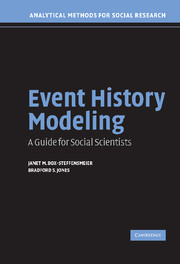Book contents
- Frontmatter
- Contents
- List of Figures
- List of Tables
- Preface
- 1 Event History and Social Science
- 2 The Logic of Event History Analysis
- 3 Parametric Models for Single-Spell Duration Data
- 4 The Cox Proportional Hazards Model
- 5 Models for Discrete Data
- 6 Issues in Model Selection
- 7 Inclusion of Time-Varying Covariates
- 8 Diagnostic Methods for the Event History Model
- 9 Some Modeling Strategies for Unobserved Heterogeneity
- 10 Models for Multiple Events
- 11 The Social Sciences and Event History
- Appendix: Software for Event History Analysis
- References
- Index
3 - Parametric Models for Single-Spell Duration Data
Published online by Cambridge University Press: 05 September 2012
- Frontmatter
- Contents
- List of Figures
- List of Tables
- Preface
- 1 Event History and Social Science
- 2 The Logic of Event History Analysis
- 3 Parametric Models for Single-Spell Duration Data
- 4 The Cox Proportional Hazards Model
- 5 Models for Discrete Data
- 6 Issues in Model Selection
- 7 Inclusion of Time-Varying Covariates
- 8 Diagnostic Methods for the Event History Model
- 9 Some Modeling Strategies for Unobserved Heterogeneity
- 10 Models for Multiple Events
- 11 The Social Sciences and Event History
- Appendix: Software for Event History Analysis
- References
- Index
Summary
The basic logic underlying parametric event history models is to directly model the time dependency exhibited in event history data. This is easily done by specifying a distribution function for the failure times. If the researcher suspects that the risk of an event occurrence is increasing, or “rising” over time, for example, then one may specify a distribution function that accounts for such a relationship. Social scientists, and in particular, political scientists, have made use of parametric methods to understand such phenomena as coalition durations (King et al. 1990; Warwick 1992), the survival of political leaders (Bueno de Mesquita and Siverson 1995), and the duration of military conflicts (Bennett and Stam 1996). Parametric models for political analysis would seem most reasonable when there exists a strong theoretical expectation regarding the “shape” of the hazard rate (or by extension, survival times), conditional on the covariates included in the model. Under such conditions, correctly specifying the distribution function will yield slightly more precise estimates of the time dependency in the data as well as more precise estimates of covariate parameters than nonparametric approaches in small samples (Collett 1994); however, if the distribution of failure times is parameterized incorrectly (for any size sample) then the nice interpretations afforded parametric models may not hold (Bergström and Edin 1992).
We make this cautionary note primarily because parametric methods directly specify the shape of the hazard rate. This will happen even if the parameterization is wrong.
Information
- Type
- Chapter
- Information
- Event History ModelingA Guide for Social Scientists, pp. 21 - 46Publisher: Cambridge University PressPrint publication year: 2004
Accessibility standard: Unknown
Why this information is here
This section outlines the accessibility features of this content - including support for screen readers, full keyboard navigation and high-contrast display options. This may not be relevant for you.Accessibility Information
- 1
- Cited by
